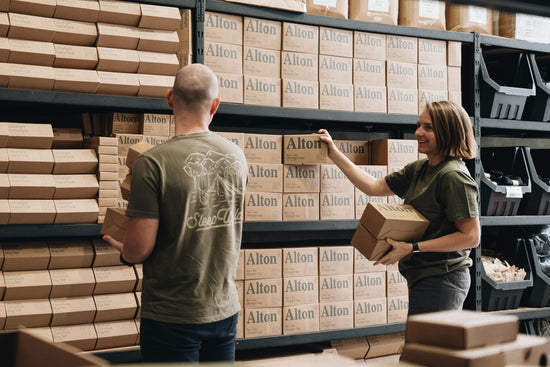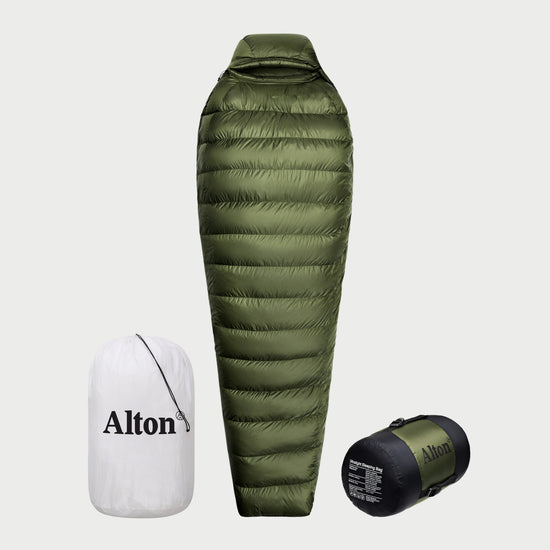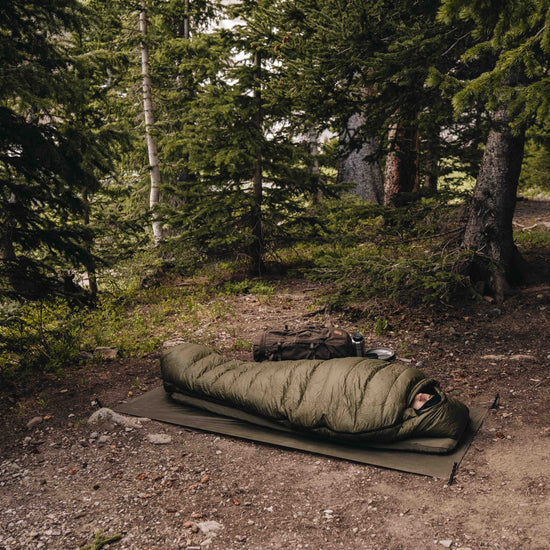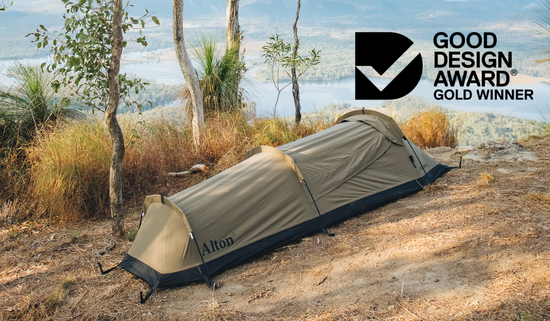There are two types of campers.
There’s the type who get back from an adventure and immediately clean, sort and put everything away.
Then there’s the type who chuck their pack down and say, “I’ll deal with that tomorrow”... and then suddenly it's a week later and they still haven’t dealt with it.
Sound familiar?
If you’re the second type, pay attention, because today we’re going down the rabbit hole of sleeping bag storage.
In this blog, we’ll tell you the step-by-step instructions for how to store your sleeping bag correctly and share our expert sleeping bag storage tips. And make sure to read to the end, because we’ll be answering a bunch of your sleeping bag storage FAQs!
But first, why does sleeping bag storage even matter?
Having a good-quality hiking sleeping bag or camping quilt can be the difference between a cosy sleep out under the stars and a bone-chilling battle with the cold, harsh night.
So it’s not surprising that most hikers agree that a sleeping bag is probably one of the most important (and most expensive) purchases that you’ll make in your entire collection of camping gear.
The upside is that a high-quality sleeping bag can last for years, if not decades – if you take proper care of it. Storage is an essential part of this.
Neglecting to store your sleeping bag correctly, such as leaving it compressed for long periods of time or not allowing it to dry out fully before packing it away, can cause serious damage.
So if you want to keep your precious sleeping bag performing at its best for longer, then you need to know the best way to store it.
So how do you store a sleeping bag?
The good news is that storing your sleeping bag is super easy. There is literally no excuse not to do it properly.
The Best Way to Store Your Sleeping Bag (4-Steps)
- Remove your sleeping bag from its compression stuff sack as soon as you return from your camping trip.
- Hang or place your sleeping bag on a rack to air out for a few hours in a well-ventilated spot away from direct sunlight. Wait until it is completely dry before proceeding to the next step!
- Stuff it in a large cotton sleeping bag storage sack (or something similar). This will protect your sleeping bag without compressing the insulation.
- Store your sleeping bag in a dry, cool place away from direct sunlight. Avoid locations with extreme temperature fluctuations or high humidity.

8 Sleeping Bag Storage Tips We Swear By
Now you know the basics of sleeping bag storage. That wasn’t so hard, was it?
But there is still more to learn when it comes to the best way to store your sleeping bag.
That’s why we’re sharing our expert tips for storing your sleeping bag and keeping it in the best condition for longer (which will save you money in the long run).
1. Use an extra-large cotton sleeping bag storage sack.
We recommend using a large storage sack made from lightweight cotton or other natural materials. This allows for natural breathability and helps to prevent moisture build-up that can contribute to mould growth.
In terms of size, we find a 90L sleeping bag storage sack works best because it doesn’t compress the insulation but can still easily fit in your closet or on a shelf.
We personally aren’t a big fan of mesh sleeping bag storage sacks because they don’t protect against dust, insects or accidental wear and tear. A cotton storage sack is perfect as it keeps your sleeping bag clean and provides a bit of extra protection as well.
2. Avoid exposing your sleeping bag to temperature extremes.
Hot and sticky situations can make camping gear (and people) rather uncomfortable. No surprises there, really!
But seriously, heat and humidity can both cause serious damage to your sleeping bag over time.
And not just the insulation – exposing your sleeping bag to high temperatures can cause the delicate outer shell fabric to degrade, as well as reducing the effectiveness of the insulation.
For this reason, it is best to store your sleeping bag somewhere that won’t experience extreme temperature fluctuations or high levels of humidity.
Avoid storing your sleeping bag in locations such as attics, basements, sheds, garages or vehicles. Not only do these areas tend to be more affected by temperature changes, they also typically have poor airflow and higher humidity. Your sleeping bag deserves better than that!
3. Store your sleeping bag zipped up.
We have come across a few sleeping bag storage articles that mention that you should store your sleeping bag unzipped…. But we disagree.
We believe it’s better to store your sleeping bag zipped up.
Why? Three reasons.
- It’s better for the zipper teeth. If you leave a zipper unzipped for a long period of time, some of the teeth may become bent, corroded or misaligned so they can no longer lock together effectively. By keeping the zipper closed, you’re ensuring that the teeth retain their shape and continue to fit together as intended.
- It’s better for the rest of your sleeping bag, too. If left open, the teeth and sharp corners of the zipper may snag or tear the delicate outer fabric of your sleeping bag. The chances of causing damage this way are low, but still, we’d rather avoid it altogether.
- It’s easier to repair bends or kinks in the zipper. If you do happen to accidentally cause a kink in a closed zipper from aggressively bending or folding it, it’s actually easier to repair if it’s on the same spot on both teeth.
That’s our hot take on sleeping bag zippers!
The same logic applies if you’re compressing your sleeping bag into a stuff sack, which is why we completely zip up our sleeping bag before packing it away.
Of course, regardless of whether you zip up your sleeping bag or not, it's still advisable to always be gentle with the zipper.
4. Give your sleeping bag some TLC every few months.
It can be tempting to chuck your sleeping bag in its cotton storage sack and forget about it until the next time you need it…
But that’s not very nice, is it?
Every month or so, we recommend taking your sleeping bag out of storage and giving it a little TLC between uses.
Fluff it up, air it out, make sure the place you’re storing it is cool, dry and not showing any signs of damp.
This helps keep your sleeping bag in good condition and prevents any specific area from being folded in one place for too long. And we like to think that it reminds your sleeping bag of just how important it is to you, too.
5. Clean your sleeping bag before putting it into long-term storage.
With regular use, dirt, sweat and body oil can work their way through the shell fabric of your sleeping bag and then into the insulation.
All that gunk can begin to weigh down the insulation and decrease the ‘fluffiness’ of the individual clusters of down or synthetic fibres. And if you put a sleeping bag into storage while it's dirty, any oil and grime that’s in there will just work its way deeper into the insulation fibres.
And that means your sleeping bag won’t be able to perform its best when you need it next.
That’s why we recommend giving your sleeping bag a bit of a clean up before throwing it into storage for a few months.
We’ve already got a blog devoted to how to clean your sleeping bag, so be sure to check that out if you think it might be time to wash yours…

All your Sleeping Bag Storage FAQs answered!
Is it OK to store a down sleeping bag in a stuff sack?
Nope. It’s not ok to store a down sleeping bag in its stuff sack for a long period of time. Full stop. There are a few reasons why this is the case:
- It can break the down clusters and reduce their ability to loft (and thus provide warmth).
- It can cause the zipper to become kinked or bent (or the teeth may no longer fit together if left unzipped.)
- It puts your sleeping bag at greater risk of mildew or mould growth.
Leaving your down sleeping bag fully compressed in a stuff sack for a couple days or even a couple months shouldn’t cause lasting damage… but if you do that enough times over the years, it will eventually cause problems.
Do synthetic sleeping bags need to be stored loose, too?
Yes, synthetic sleeping bags need to be stored loose.
In fact, the exact same sleeping bag storage advice applies, regardless of whether you have a synthetic sleeping bag or a goose down sleeping bag or a duck down sleeping bag or a woolly mammoth hair sleeping bag… actually we’re not sure about that last one.
If you’re wondering whether synthetic sleeping bags are more resilient than down sleeping bags, the answer is no, not really.
In fact, synthetic insulation is often more delicate than down. Recurring compression can cause the synthetic fibres to break and lose some of their loft faster than it would for down.
On the other hand, untreated down insulation can be more susceptible to clumping or mould growth if exposed moisture, but it is much better at retaining loft over time, even with frequent use.
The moral of the story is that you need to properly store your sleeping bag, regardless of whether it is down or synthetic.
Should I hang, roll or fold my sleeping bag?
We advise against rolling or folding your sleeping bag. These methods can cause wear and tear because they tend to be very ‘regular’, meaning they put strain on the same parts of your sleeping bag over and over again.
Hanging your sleeping bag is an ok option, but you need to make sure that you have an extra-wide, soft hanger – like those colourful knitted ones you used to find at Grandma’s house. And make sure you adjust the position of your sleeping bag now and then so it’s not always putting pressure on the same spot.
The preferred method to put your sleeping bag into its stuff sack or cotton storage sack is just to, well, stuff it in there randomly. This prevents your sleeping bag from being folded repetitively in the same place, which helps keep it in good condition for longer. Easy!
Is it OK to vacuum pack sleeping bags?
Nooooo, not the vacuum packer!
If someone in your household has discovered the wondrous, life-changing magic of vacuum packing, then you’re in big trouble.
Whatever you do, DO NOT let them get their hands on your sleeping bag.
And if you’re the one with a vacuum packing addiction, then listen up: it’s NOT ok to not vacuum pack sleeping bags.
It is like compressing them in a stuff sack, but worse, because that fancy vacuum packing machine will literally suck all the air (and life) out of your sleeping bag.
Can I store my sleeping bag in a box?
Storing a sleeping bag in a plastic box isn’t ideal because there is limited air-flow, so any moisture in there may stick around and cause problems.
And it’s not just a matter of thoroughly drying your sleeping bag before putting it in said plastic storage box. Changes in temperature and humidity levels outside can cause tiny amounts of moisture to accumulate inside the box, which can lead to problems if you leave it like that for too long.
Even so, if you have to store your sleeping bag for a long period of time and aren’t confident it will be safe in a cotton storage sack alone, then a large plastic bin may be your best option.
In that case, try to keep the box somewhere that won't be exposed to extreme temperature fluctuations or damp, and consider chucking an anti-humidity/moisture absorber packet in there, too.
Can I store my sleeping bag in a waterproof dry bag?
Just like a box, a waterproof dry bag isn't going to allow your sleeping bag to breathe, so moisture build-up may become an issue.
If you’re concerned about water damage, the best case scenario is going to be finding an alternative place to store your sleeping bag.
Where are the best places to store a sleeping bag?
The best place to store a sleeping bag is somewhere that’s dry, well-ventilated, maintains a fairly steady temperature year-around, and ideally doesn’t get warmer than 25ºC.
If that’s sounding like a tall order, don’t worry. Here are some specific suggestions to help you find the best place in your house to store your sleeping bag:
-
In your closet or wardrobe. A large closet or wardrobe makes the perfect storage area for a sleeping bag because they are usually dry and cool with decent ventilation. You can place your sleeping bag (inside its cotton storage sack) on a high shelf or even on the floor, provided nothing else is going to squash it.
-
On top of your wardrobe. If you don’t have space inside your wardrobe, maybe you can place it on top. This spot is usually great for ventilation and airflow, but be mindful of how hot the room gets when considering this option.
- Under your bed. If you have a high enough bed frame or under-bed storage, then underneath your bed can be a decent place to store your sleeping bag. You can even lay it flat in a large storage bag or wrapped inside a cotton sheet. Just make sure you check on it regularly and keep the area as clean and dust free as possible.
That’s it for today, folks!
Now you know how (and why) to store your sleeping bag correctly – so there is no excuse not to do it properly.
Like all outdoor gear, your sleeping bag's lifespan is going to be highly dependent on how well you care for it.
So what are you waiting for? Go put what you’ve learned into practice!
















